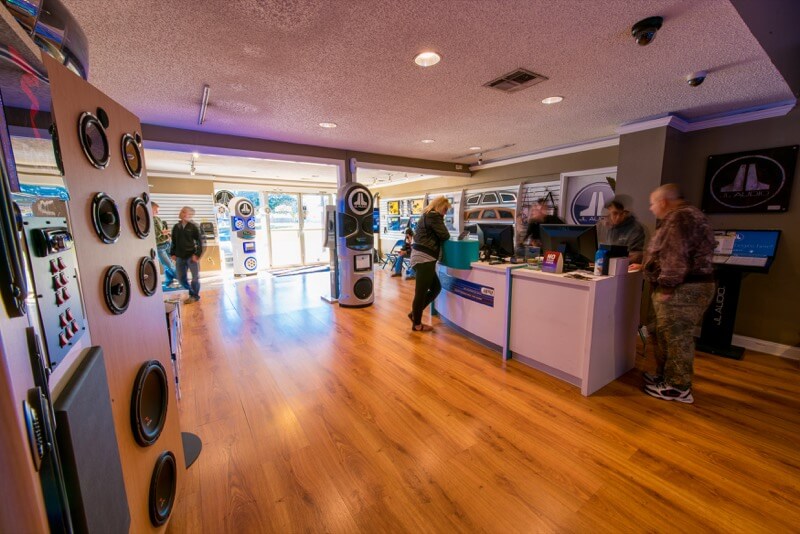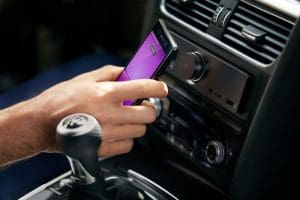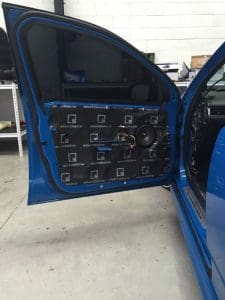
Photo courtesy of Prestige Car Audio and Marine in Metairie, LA
Brought to you by our friends at BestCarAudio.com
When it comes to buying or upgrading a car audio system, there are hundreds of products to choose from and dozens of questions for you to ask the sales staff at your local car audio retailer. This article provides some basic guidelines to help make the process easier for you, and ensure you get the equipment and service that fulfills your goals.
1. What is your point?
Have you ever been driving while listening to music and thought to yourself, “That doesn’t sound right” or “This system doesn’t get loud enough”? Even worse, maybe you have headphones on – something that is illegal in many states and provinces. If there has even been a thought other than “I love my car stereo,” then you should make a visit to your local car audio retailer. Before you go, make sure you know why you are going. Is part of your system broken? Do you want a radio with a new feature? Do you want better sound quality? more overall volume? a little more bass? a lot more bass? Knowing what to ask for will help you arrive at the perfect audio solution quickly and efficiently.
 If you have friends with aftermarket car audio systems, ask them if you can have a listen. Write down what you like about their systems and what you would do differently. If you enjoy your music loud, take some notes on a system that you think plays loudly enough – the make and model of speakers, amplifiers and subwoofers. If there was something you liked, like a pair of speakers or radio, write down the model numbers. Do the same for your existing system. If you provide clear goals, your retailer can narrow down upgrade suggestions accurately and efficiently.
If you have friends with aftermarket car audio systems, ask them if you can have a listen. Write down what you like about their systems and what you would do differently. If you enjoy your music loud, take some notes on a system that you think plays loudly enough – the make and model of speakers, amplifiers and subwoofers. If there was something you liked, like a pair of speakers or radio, write down the model numbers. Do the same for your existing system. If you provide clear goals, your retailer can narrow down upgrade suggestions accurately and efficiently.
A request from your retailer: Be honest about your goals and expectations. If you tell your dealer that you just want a small sub, but you like the sound of a pair of 12s in the back of your friend’s truck, you will end up being disappointed, and will likely push the system beyond its limits or to the point of failure. Ask for what you really want, and you will get something you will enjoy.
2. The Latest Thing
 Over the past five years, the number of people who have chosen to add some form of Bluetooth hands-free solution to their vehicles has been considerable. If the solution has been a new head unit, then they also get USB for music playback from their phones or memory sticks. If there is something new that you want, let your retailer know. Some popular upgrades include a new source unit with CarPlay or Android Auto interfaces, cellphone voice dialing, SiriusXM satellite radio, a backup camera or parking sensor system, or a source unit with a Pandora Radio interface or support for high-resolution audio files like FLAC. Your local dealer would be happy to show you some of the features and products available to the mobile electronics industry.
Over the past five years, the number of people who have chosen to add some form of Bluetooth hands-free solution to their vehicles has been considerable. If the solution has been a new head unit, then they also get USB for music playback from their phones or memory sticks. If there is something new that you want, let your retailer know. Some popular upgrades include a new source unit with CarPlay or Android Auto interfaces, cellphone voice dialing, SiriusXM satellite radio, a backup camera or parking sensor system, or a source unit with a Pandora Radio interface or support for high-resolution audio files like FLAC. Your local dealer would be happy to show you some of the features and products available to the mobile electronics industry.
3. Check it out
Once you have narrowed down your reason for visiting a retailer, you should have a plan to audition the product you have chosen. If it’s a radio, using it on a display board can often tell you almost everything you want to know. Make sure the user interface is easy to use and to understand. If it has Bluetooth, make sure your phone will pair with it and reconnect automatically every time you turn on the radio. If you are looking at a multimedia source unit, make sure you know how long it takes to start up when you start your car. This is important if you are adding a backup camera to the vehicle. Waiting for the radio to start so you can use the camera to back up is somewhat frustrating.
If you are after speakers or a subwoofer system, then auditioning those in a vehicle is a great idea. Once you have established how the products sound, you can listen to different speakers or subs on a display board in the store, and reference the difference from the product you listened to in the car.
4. What Flavor?
Do you need an audio system with everything from a single manufacturer? Absolutely not. While there is nothing wrong with having amps and speakers from the same company that makes your radio, different companies have different areas of expertise. The store you are dealing with carries certain brands for several reasons. Typically, a retailer chooses brands for their performance, reliability, and how easily the store owners can work with the manufacturer or supplier. When a store has a good relationship with a supplier, that often translates into better pricing and service on the products for the store, and subsequently for you.
Some consumers are skeptical about why a brand is suggested to them. That is not unreasonable, since many big box retailers are prone to pushing products that are profitable for them. Do your research and audition the products for yourself. If you like something different, then go with that. Just make sure your comparisons are “apples to apples” as best you can, and are based on fact, not reputation.
5. Trained Professionals
 When it comes to handing over the keys to your car or truck, you want to know that the person working on the vehicle knows exactly what they are doing. There are programs like MECP (Mobile Electronics Certified Professional) and various local and regional government-run qualification standards that can help to quantify the skillset and knowledge of the person who will be working on your vehicle.
When it comes to handing over the keys to your car or truck, you want to know that the person working on the vehicle knows exactly what they are doing. There are programs like MECP (Mobile Electronics Certified Professional) and various local and regional government-run qualification standards that can help to quantify the skillset and knowledge of the person who will be working on your vehicle.
It is also worthwhile to ask to look at some of the work the shop has done. You want to ensure that everything is always neat and tidy when it comes to wire routing, and that products are mounted safely and securely. A neat and tidy installation area can be a good sign. You can often quantify the reliability of a shop by its clientele – if there are high-end cars around, then it probably has a good reputation.
6. Do It Yourself?
 Over the years, do-it-yourself car audio installations have allowed people to learn a great deal about how their systems work. With the quality of factory systems improving day by day, the challenge of installing something “better” is becoming more and more difficult. Understanding polarity, phase, summing, equalization and time alignment is paramount to a successful installation. From a physical installation standpoint, working with aluminum chassis vehicles or ones with adhesive panel bonding and data communication buses poses unique challenges. Finally, even choosing a location to mount equipment has become more difficult. There are multiple computers scattered around modern vehicles, and any one of them could be a potential source of audio interference.
Over the years, do-it-yourself car audio installations have allowed people to learn a great deal about how their systems work. With the quality of factory systems improving day by day, the challenge of installing something “better” is becoming more and more difficult. Understanding polarity, phase, summing, equalization and time alignment is paramount to a successful installation. From a physical installation standpoint, working with aluminum chassis vehicles or ones with adhesive panel bonding and data communication buses poses unique challenges. Finally, even choosing a location to mount equipment has become more difficult. There are multiple computers scattered around modern vehicles, and any one of them could be a potential source of audio interference.
All of these are reasons not to do it yourself, but to turn to an established, reliable, knowledgeable shop.
7. Hook Me Up!
Modern vehicles offer many challenges when it comes to installing audio equipment. In many new vehicles, it is impossible to remove the factory radio because other vehicle functions are incorporated into it. In the case of these vehicles, you will want to make sure the shop you are working with has the tools and knowledge to test the factory audio equipment properly for signal connection points and deal with any integration challenges that come up. There are many products on the market designed to integrate with factory audio systems; ask your retailer which they use and why.
8. Stepping Higher
 If you are looking for real performance from your audio system, your retailer may suggest several accessories that can improve that performance. Adding sound-deadening to your vehicle should be at the top of your list. Properly installed sound-deadening not only makes the vehicle quieter but can improve the performance of your speakers by preventing the sound coming from the rear of the speaker from canceling with the sound coming from the front. Bluetooth systems work better when the vehicle is quieter, and most sound-deadening materials also block heat, so your vehicle will be more comfortable. A moderately priced set of speakers installed with proper sound-deadening can sound better than an expensive set without deadening.
If you are looking for real performance from your audio system, your retailer may suggest several accessories that can improve that performance. Adding sound-deadening to your vehicle should be at the top of your list. Properly installed sound-deadening not only makes the vehicle quieter but can improve the performance of your speakers by preventing the sound coming from the rear of the speaker from canceling with the sound coming from the front. Bluetooth systems work better when the vehicle is quieter, and most sound-deadening materials also block heat, so your vehicle will be more comfortable. A moderately priced set of speakers installed with proper sound-deadening can sound better than an expensive set without deadening.
If the shop needs to create adapter rings for your speakers, what materials are they using? Ideally, you want something that will not be harmed by water – ABS plastic, HDPE plastic, or Lexan and plexiglass materials are great choices.
A higher-end installation may start to involve some cosmetic fabrication. Many shops are adept at creating trim and accent panels that can add unique style to your system and you vehicle. Materials like leather, vinyl, suede, transparent plastics and mesh are very commonly integrated into custom door, dash and trim panels. Shops should have some samples of their work on display so you can see what they offer.
9. Play Me a Tune
 One of the most critical aspects of installing any car audio system is ensuring that each speaker is working in harmony with all the others in the vehicle. From the simplest check of balance and fader controls to ensuring that the acoustic polarity of your subwoofer is correct, each system deserves a good listen by your installer before it leaves the install bay.
One of the most critical aspects of installing any car audio system is ensuring that each speaker is working in harmony with all the others in the vehicle. From the simplest check of balance and fader controls to ensuring that the acoustic polarity of your subwoofer is correct, each system deserves a good listen by your installer before it leaves the install bay.
As you delve deeper into the quest for realism and sonic perfection from your audio system, you will no doubt encounter Digital Signal Processing (DSP). There are several source units and amplifiers on the market with great DSP features, and the standalone processors are amazing. The key to the success of any of these systems starts with the design of the system and finishes with proper tuning. You will never get a great soundstage in front of you if your speakers are beside you. Auditioning a shop’s skills in tuning DSP systems can usually only be done in a vehicle, although a few shops have some dramatic displays in their showrooms. Have a listen to the demo vehicle.
10. After the Fact
Once your system is installed and tuned, the shop should give you a thorough walk-through of how it works, what adjustments you can make and what you should not touch. If you find that you don’t like some aspect of the system’s performance, then go back to the shop. Do not start turning dials and pushing buttons on your own – if the system was tuned properly and you start messing with it, you are more than likely to start to damage your equipment. This is a nice way of asking you not to turn up the gains on your amps.
Many shops offer lifetime installation warranties on products they install. Don’t get hung up if they don’t – it’s the philosophy of more and more shops to invest in making the installations they do so good that there is almost no chance of failure. Talk to your salesperson and understand their logic. In this case, the right answer is the one that works best for you.
Also, be sure to ask about the warranty on the products you are purchasing. Many car audio products have longer warranties when they are installed by an authorized dealer. Ask the shop what happens if something breaks. A few shops offer a direct exchange program; some send the product away for repair. Just make sure you understand how your shop of choice handles things before you make the purchase.
Buying Car Audio
The bottom line: Work with a competent retailer and you will end up with an audio system that sounds amazing and lasts for years and years. Great-sounding music can make a drive much more enjoyable.
This article is written and produced by the team at www.BestCarAudio.com. Unauthorized use is prohibited without the express written permission of the owner.

Leave a Reply